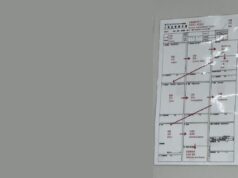Learned 2 things from this pic: men are taller than women; wh… on Twitpic
Scott McDuffee referenced the “Yogi-ism” the other day, that you see a lot just by watching or observing. When we teach people Lean in hospitals, half of the battle is “Learning to See” the waste that surrounds them in their processes and work. There's a good reason that the famous book by Rother and Shook (from the LEI) isn't called “Learning to Value Stream Map” — learning to see is a critical skill. You have to see problems and then (also important) FIX things.
The link at the top of the post is a picture I took at a hospital yesterday, click below for a slightly larger view (the image is of somewhat crap-tastic quality, taken with my BlackBerry):
Look at the metal push plates on the doors. One thing I learned is that men are generally taller than women based on where they push (OK, I already knew that fact, but this confirms it). People are tending to push ABOVE the metal plate, wearing away the stain on the door, increasing costs to the hospital if they repaint the door often, or it looks bad and unkempt right off their main lobby (thanks to @opexdirect on twitter for some thoughts on that).
Now we're speculating, since I didn't talk to anyone about the issue (it was just something that caught my eye in passing). Is the right solution to just repaint the door every year? What else could we do to “fix” this in the long term? What's a better countermeasure?
I have a few ideas, but what do you think? Click comments to share your ideas.
What behavior would you want to see in your organization if this was you? What response would you want from the maintenance team if they saw this or if they spent time repairing the problem?
Subscribe via RSS | Lean Blog Main Page | Podcast | Twitter @markgraban
What do you think? Please scroll down (or click) to post a comment. Or please share the post with your thoughts on LinkedIn – and follow me or connect with me there.
Did you like this post? Make sure you don't miss a post or podcast — Subscribe to get notified about posts via email daily or weekly.
Check out my latest book, The Mistakes That Make Us: Cultivating a Culture of Learning and Innovation:











Longer push plates that would cover the area where the stain is rubbing off.
Another option would be to have a person stand there for awhile with a diagram of a push plate and mark the spot on the plate they push when they enter, then move the plate accordingly based on your data, but since based on the photo we know that touching the plate low is not an issue, why risk it becoming an issue? Keep it a non-issue.
Other thoughts?
Maybe the door users are purposefully missing the plate to avoid germs left by others? Should talk to the users, not just watch maybe. Maybe moving the plate would be waste if people still miss intentionally??
I believe you are right Mark. I always pull on the bottom of public door handles, not in the middle. Or push, with a little more effort, in the middle of the door and avoid the hotspot altogether. Why even bother with the push plate? People will push the door open with or without it. Restaining is inevitable, with or without it. I say order doors without them. Ha! Then what would the perception be by users?!>
A stainless steel door would be much more sanitary (on both the inside and outside) and eliminate the wear issue.
Hold out for the elegant solution here. Don’t rely on your own bias, take Mark’s advice: observe to find the cause and context. And ask whether the metal plate is a good solution in the first place!
I believe that what Yogi said was “You can observe a lot by watching.”
Quarterman — you’re right, wow I had a brain cramp on that one!
I usually tend to push the doors with my legs to avoid touching it. Did the door have metal plates in the bottom?
If line-of-sight is addressed by having a interior wall in the restrooms, then a door is not necessary. Since this is a hospital setting, door removal would also be friendlier to those with canes or wheelchairs. And this would also help when wanting to limit germs when pulling the door open to exit. I’d also suggest that the tile/flooring have pink vs blue coloring at the entrance to reinforce the vertical signage.
No “kick plates” at the bottom of these doors, good question, though, Sankara.
So maybe the elegant solution is no door at all?
In this case, with the bathroom layout, removing the door wouldn’t work, but it’s a good architecture lesson for future hospital design, maybe.
The “no door” twist and turn entrance to airport bathrooms often annoys me. Yes, there’s no door to push, but it’s very difficult for two people to go opposite directions through the twists and turns while dragging rolling suitcases.
Now you’ve got me looking at doors everywhere! The bathroom doors in the office have small push-plates and a lot of obvious wear on the wood directly above the push-plate. The fire doors have longer plates and no wear pattern. See how sad I’ve become.
Seriously, what this reminds me is how much waste is often designed into equipment (and as a corollary, how much it costs to put right after it’s up and running). A bit more time and thought on design and spec (and proper engagement with customers at this stage) equals much lower lifetime cost. (Not just for doors.)